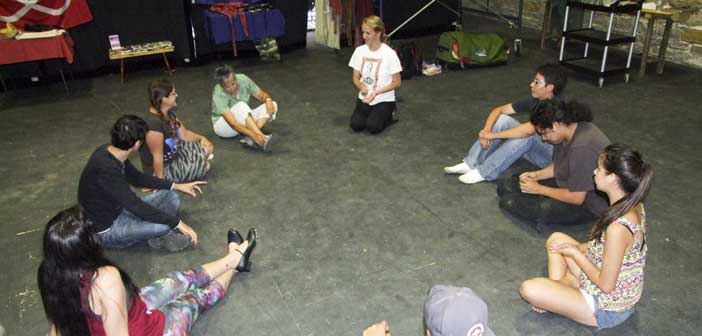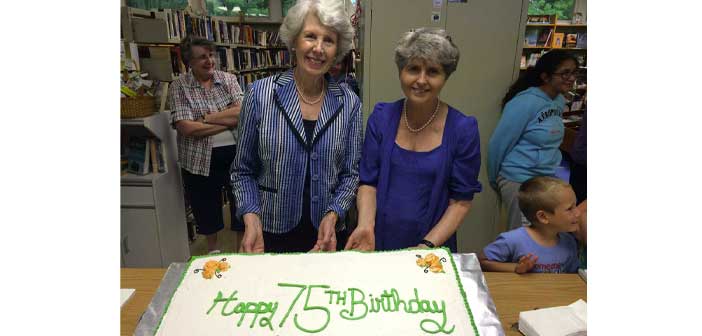MANITOWANING—Opportunities to interact and learn about First Nations culture abound on Manitoulin, with a plethora of powwows and workshops available in all of the Island’s reserve communities throughout the year, especially during the summer season, but when it comes to educational opportunities focussing on the culture of the Métis, who make up 32 percent of the constitutionally recognized aboriginal population in Canada, not so much.
So when the opportunity to take part in traditional Métis workshops at the Debajehmujig Storytellers Creation Centre in Manitowaning arose The Expositor quickly slipped on its dancing shoes and headed out to a Thursday session.
Compaini Vini Dansi artistic director Yvonne Chartrand and the Louis Riel Dancers, including award winning artistic associate Madelaine McCallum, Luis Canton, M. Pyress Flame and Métis fiddler J.J. Lavallee, have come to Manitoulin on a mission to spread their passion for the culture through dance and song.
Our workshop included Ms. Chartrand, Ms. McCallum and Mr. Lavallee, as the rest of the troupe were not arriving until the following week.
“I started Métis dancing and jig at the same time in 1985,” said Ms. Chartrand, who found herself drawn to choreography at a very young age. “Before I even knew what choreography was,” she laughed. Like many western Canadians, where it is estimated as much as half of the population have aboriginal bloodlines in their family tree, Ms. Chartrand grew up in a modern Métis community, and although her father taught her much about her heritage, it was at the University of Manitoba that she learned the historical aspects of dress, dance and music.
“Louis Riel once said ‘my people will sleep for 100 years, but when they awake, it will be the artists who give them their spirit back’,” she said, recounting the spiritual impact her discovery at university had. “As an artist, the experience brought an awareness that opened up a world for me.”
As we sat in a circle on the floor, a talking stone (similar to the talking stick used in many Anishinaabe gatherings) was passed hand-to-hand clockwise with each participant encouraged to introduce themselves and to talk a bit about their interest in the workshop. “There are many different traditions,” said Ms. Chartrand. “This is how I was taught.”
Some of the participants were WWOOFRs (World Wide Opportunities on Organic Farms) participants who are at Debaj to learn about the interactions between the land and art, while others are students from local First Nation communities collecting community hours working at Debaj for the summer and yet others are folks simply interested in learning about the Métis culture and dance.
Ms. McCallum, we learn, is a young Métis woman originally from Ile a la Crosse, Saskatchewan. While her main focus is Métis dance (she’s been jigging since she could walk), she said that she enjoys all forms of dance including powwow, contemporary and hip hop. “Dance has carried me through many challenges in my life,” she shared.
A little digging at the Vini Dansi website provided a bit more about this engaging young woman. She has performed for the Métis Nation British Columbia and Métis National Council organizations and in the opening ceremonies for the 2010 Winter Olympics. An experience she said still resonates in her spirit.
Ms. McCallum has spent the past eight years working with the Louis Riel Métis Dancers on traditional Métis dance. In 2009, she won first place at the Batoche Days celebrations. “She beat out all the boys,” laughed Ms. Chartrand. Ms. McCallum also models for an aboriginal clothing line, Artifaax Clothing, and works at the Women Against Violence Against Women Rape Crisis Centre as the aboriginal youth facilitator.
Mr. Lavallee was born and raised in the community of St. Ambroise, Manitoba and began singing at the tender age of six. By the time he was nine, Mr. Lavallee was playing his first guitar, and by 16, he was a regular in his uncle’s band.
“I play by…(pointing to his ear),” said Mr. Lavallee. “I have never read a note in my life.” He may not follow the notes on bars, but this fiddler is highly accomplished, winning two awards at the 2007 Aboriginal Music Awards in Winnipeg.
Sometimes accompanied on the spoons by Ms. Chartrand, who did triple duty as instructor and square dance caller, Mr. Lavallee provided lively traditional Métis tunes for the dancers’ jigs.
The first jig up was possibly the most familiar, the Red River Jig. A simple heel-toe-heel step is the first part, an old style, not too hard for a two-left-foot journalist to follow. “The women’s dance step traditionally never left the ground,” said Ms. Lavallee. “Their feet always stayed in contact with Mother Earth.” But the second part of the Red River Jig is far more complex (I stayed upright, barely).
Ms. Chartrand noted that Métis scholar John Arcand said that the elders had told him during his research that there were as many as 100 fancy steps in the Métis jig lexicon. Many of those steps are now being brought back.
Through the workshop we also discover the 7 Step, maybe it should be called the 7 Step, then three-step, then seven step then twirl, you get the picture. If not for the gentle patience of dance partner M. Chartrand, it might have been called the 7 Stumble-Trip, but she managed to also guide me through the Butterfly Dance, the Infinity Square Dance and the Scottish-influenced Belt Dance, similar to the warriors’ sword dance.
The Métis dance steps, like the people, seem to be an amalgam of European and aboriginal movements, with the combination melding into a unique art form with a style of its own.




